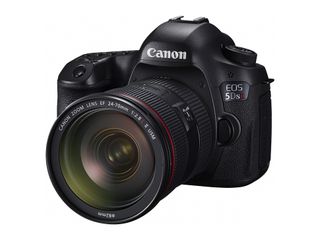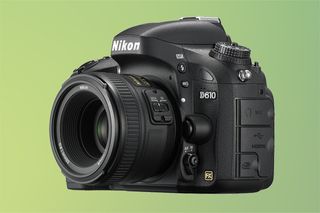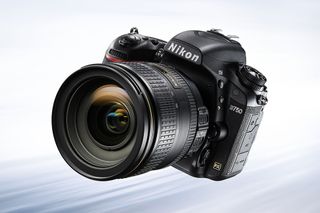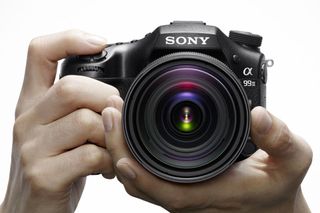13.36.52 The best full-frame DSLR in 2018 | |
Big is best when it comes to sensor size and image quality
Full-frame DSLRs have long been the cameras of choice for photographers in pursuit of optimum image quality and performance, and a number of very different models can be bought at a reasonable price. Compared with APS-C and smaller image sensors, full-frame sensors enable individual pixels to be physically larger, so they can gather more light. This gives the potential for relatively noise-free images, even at high ISO settings. Alternatively, camera makers can pack full-frame sensors with more megapixels for brilliant rendition of fine detail and texture. Full-frame cameras also allow for a much tighter depth of field for portraiture and still-life photography. So, there are many reasons for creative photographers to opt for these, but value for money varies widely across different models. Therefore, it's worth investigating the full range of what's out there to make sure you're getting the best model for your needs. Here are the key contenders for your attention.
1. Canon EOS 6DThis old-timer still has some life in it Type: DSLR | Sensor: Full frame | Megapixels: 20.2MP | Lens mount: Canon EF | Screen: 3in fixed, 1,040,000 dots | Viewfinder: Optical | Max burst speed: 4.5fps | Max video resolution: 1080p | User level: Enthusiast/professional Built in Wi-Fi and GPS Least expensive body on test Viewfinder coverage less than 100% Only 11 AF points (and just one cross-type) The EOS 6D is a veteran of the full-frame DSLR market. On the plus side, it’s the least expensive camera body on test and gives full access to Canon’s enviable range of EF lenses, and it also boasts built-in Wi-Fi and GPS. However, the EOS 6D has a relatively low 20.2MP count, and its antiquated autofocus system only offers a paltry 11 AF points. The modest megapixel count and DIGIC 5+ processor deliver wonderfully low-noise images throughout an impressively large sensitivity range, and colour rendition is very natural, while auto white balance and metering are consistently reliable. Overall, Canon’s budget full-framer is capable of delivering very pleasing results, and it's now joined by a newer and more expensive EOS 6D Mark II. But, you know what? For the money, we still like the old one.
2. Canon EOS 5DS RMore megapixels than any other full-frame DSLR Type: DSLR | Sensor: Full frame | Megapixels: 50.6MP | Screen: 3.2in fixed, 1,040,000 dots | Viewfinder: Optical | Max burst speed: 5fps | Max video resolution: 1080p | User level: Professional 50.6MP image sensor Awesome detail and texture capture Noisy high-ISO images Value for money The EOS 5DS R is virtually identical to the older EOS 5D Mark III in external appearance and handling, which is no bad thing. Canon has, however, redesigned the newer body to be more rigid yet slightly lighter, and there’s a new shutter unit that reduces vibrations. For capturing detail and texture, the EOS 5DS R is simply epic. Indeed, some of Canon’s own EF lenses didn’t make it onto the approved list for use with this camera because they’re not sharp enough to do it justice. The trade-off is that high-ISO images are relatively noisy, and it's presumably for this reason that Canon has limited the standard ISO range a maximum ISO 6,400 setting, so it's not necessarily the best option if low-light shooting is your thing. The model was launched alongside the more affordable EOS 5DS, which is largely the same model, save for the fact that the effects of its optical low-pass filter are not cancelled out (whereas here, they are, for better detail).
3. Canon EOS 5D Mark IVJack of all trades and master of most of them Type: DSLR | Sensor: Full frame | Megapixels: 30.4MP | Screen: 3.0in fixed touchscreen, 1,620,000 dots | Viewfinder: Optical | Max burst speed: 7fps | Max video resolution: 4K | User level: Professional Great 61-point AF system Fast live view autofocus Big crop factor for 4K video Inefficient Motion JPEG format The EOS 5D Mark IV’s sports Canon's latest-generation sensor and builds on the bones of the EOS 5D Mark III in a number of key ways. The metering system and 61-point autofocus module are updated, for example, with all of the AF points supporting f/8 lens-teleconverter combinations. Live view autofocus is also excellent, thanks to Canon's Dual Pixel CMOS AF system. Weather-seals are also improved, while a new touchscreen speeds you through menu choices, and Wi-Fi, NFC and GPS have all been added. 4K video capture is also on hand, and this produces excellent results, although this does come with a heavy crop factor, and records using the somewhat inefficient and the Motion JPEG format. Image quality is great, though, with high-ISO images managing to be more detailed than those from the EOS 6D yet equally free from noise.
4. Nikon D610Not the newest DSLR but superb value for money nonetheless Type: DSLR | Sensor: Full frame | Megapixels: 24.3MP | Screen: 3.2in, 921k dots | Viewfinder: Optical | Continuous shooting speed: 6fps | Max video resolution: Full HD | User level: Enthusiast Lightweight body Excellent image quality Screen fixed in place No Wi-Fi or NFC The Nikon D610 is still Nikon's cheapest full-frame DSLR, and if you don't need the latest features it's well worth considering. Sure, it may not have all the fancy tricks of the D750 (below) such as a tilting screen or Wi-Fi, but you still get a 24.3MP full-frame sensor, two card slots, Full HD video and a (fixed) 3.2in LCD. Image quality is excellent and the autofocus system works very well, despite the fact that it's not quite the newest module Nikon offers. The D610 would be a great first-time, full-frame camera, or alternatively a capable backup body for a more advanced model.
5. Nikon D750Versatility, value and very good image quality Type: DSLR | Sensor: Full frame | Megapixels: 24.3MP | Screen: 3.2in tilting screen, 1,228,800 dots | Viewfinder: Optical | Max burst speed: 6.5fps | Max video resolution: 1080p | User level: Enthusiast/professional Tilting screen Great 51-point AF system No 4K video No touchscreen For all-round abilities, the D750 has established itself as our favourite Nikon DSLR. The 24MP sensor includes an optical low-pass filter to protect against moiré patterning and false colour, and this is coupled with an EXPEED 4 processor, while the body is finished with tilting rear screen and dual card slots. On the inside, Nikon has furnished the camera with a 51-point AF system, Wi-Fi and the option to shoot at up to a very respectable 6.5fps High-ISO image quality is about as noise-free as the Canon EOS 6D, but the D750’s 51-point autofocus system is streets ahead. Image quality is sumptuous in all respects, and overall performance is spectacular considering the camera’s relatively low price. This is arguably the best-value Nikon DSLR you can get right now. Advertisement
6. Nikon D850With a 45.7MP sensor, fast burst shooting and 4K video, the D850 truly does it all Type: DSLR | Sensor: Full frame | Megapixels: 45.7MP | Screen: 3.2in tilting touchscreen, 2.6million dots | Viewfinder: Optical | Max burst speed: 7fps | Max video resolution: 4K | User level: Professional Superb image quality Acclaimed AF system Buffer drops when shooting 9fps Pedestrian live-view AF It's hard to think of a camera that's made as much of an impact as the D850 in recent years, and it certainly has some strong competition. Whereas most DSLRs have either high-resolution images or speed and sensitivity as their priority, the D850 manages both, with its 45.7MP sensor, 7fps burst shooting mode and the same 153-point AF system that won many fans when it first featured in the D5 heading up a long list of impressive specs. Add to that 4K video, a superb build quality and all the customisation you need, and you can see just how much it's likely to appeal to a landscape photographer as it might a wedding or event shooter. Right now, perhaps the only mark against it is the fact that Nikon also has a number of excellent full-frame alternatives that cost a little less, such as the compact D750 and the D810 that it replaces. Still, if it the latest tech, versatility and quality of both stills and video you're after, right now there's nothing else like it. Read more: Nikon D850 review
7. Pentax K-1Left-field competitor with some very strong features Type: DSLR | Sensor: Full frame | Megapixels: 36.4MP | Screen: 3.2in pivoting screen, 1,037,000 dots | Viewfinder: Optical | Max burst speed: 4.4fps | Max video resolution: 1080p | User level: Enthusiast/professional In-body image stabilisation Rugged articulating rear screen Autofocus system not the best Video specs could be better Despite a very reasonable asking price, the robust, weather-sealed body is packed with advanced features and shooting controls. The K-1 has a sizeable 36.4MP count; the articulated rear screen can tilt laterally as well as vertically; sensor-shift image stabilisation works with any lens and has a highly effective five-axis action; and both GPS and Wi-Fi are built into the body. Image quality is very good but, despite a huge sensitivity range, image noise is prevalent in high-ISO shots. Autofocus is accurate but doesn’t quite match Canon and Nikon cameras for tracking fast-moving subjects. Still, for this kind of price, the K-1 absolutely trounces its rivals where features are concerned – it's an absolute steal.
8. Sony Alpha 99 IIHuge resolution, huge speed, huge achievement Type: DSLR | Sensor: Full frame | Megapixels: 42.4MP | Screen: 3in pivoting screen, 1,228,800 dots | Viewfinder: EVF | Max burst speed: 12fps | Max video resolution: 4K | User level: Enthusiast/professional Sony's E-mount gets the best lenses now Bigger and beefier than the A7R II compact system camera, the A99 II is, strictly speaking, not a DSLR, but close enough in design and intentions to be considered alongside them. It offers more assured handling and feels better balanced with most full-frame lenses. There’s a hybrid autofocus system but, unlike that of the A7R II, it includes phase-detection on both the image sensor (399 points) and a separate AF module (79 points). Five-axis sensor-shift image stabilisation features, as does a 2.36MP OLED electronic viewfinder, while the rear screen offers full articulation rather than just vertical tilt. The camera also boasts blisteringly fast 12fps continuous shooting, complete with autofocus tracking and live metering. In recent years, Sony's attention has shifted away from its SLT bodies to its A7 and A9 compact system cameras lines, and this places the future of the system in doubt. Still, for now, we like the A99 II – a lot. Read more: Sony A99 II review | |
|
| |
| Total comments: 0 | |








